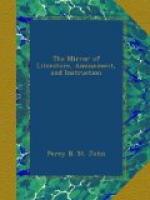“The trees which at present form so much of the beauty of Greenwich Park were planted by Evelyn, and if he could now see them he would call them ‘goodly trees,’ at least some of them. The chestnuts, however, though they produce some fine fruit, have not thriven in the same proportion with the elms. In noticing this park I should not forget to mention that the only remaining part of the palace of Henry VIII. is preserved in the front of Lord Auckland’s house looking into the park. It is a circular delft window of beautiful workmanship, and in a fine state of preservation. There are also a great number of small tumuli in the upper part of the park, all of which appear to have been opened.”
“In addition to the herd of fallow deer, amounting to about one thousand six hundred, which are kept in Richmond Park, there is generally a stock of from forty to fifty red deer. One fine stag was so powerful, and offered so much resistance, that two of his legs were broken in endeavouring to secure him, and he was obliged to be killed. One who had shown good sport in the royal hunt, was named ‘Sir Edmund,’ by his late Majesty, in consequence of Sir Edmund Nagle having been in at the ‘take’ after a long chase. This stag lived some years afterwards in the park; and its a curious fact that he died the very same day on which Sir Edmund Nagle died.”
The volume contains some interesting antiquarian inquiries respecting Caesar’s ford at Kingston, and Maxims for an Angler, by a Bungler.
* * * * *
THE SKETCH BOOK
THE ABBOT OF TEWKESBURY.
(For the Mirror.)
“After life’s fitful fever
be sleeps well.”
Shakspeare.
(In opening the tomb of the founder of the Abbey at Tewkesbury, the body of the Abbot was found clothed in full canonicals. The crosier was as perfect as when, perhaps, first put in the coffin, while the body showed scarcely any symptom of decay, though it had been entombed considerably above six hundred years. On exposure to the air, the boots alone of the Abbot were seen to sink, when the tomb was ordered to be sealed up, and his holiness again committed in his darkness. On the above circumstance this sketch is founded.)
Is this to be dead? Am I not clad in all pontifical splendour? Do I not feel the crosier on my breast? The holy brethren of the Abbey surround me. That which distinguished the Abbot when alive, is even here in collected magnificence. I feel the priestly consequence of the Abbot. Is this then the Chamber of the Dead? The pious monks are weeping. The tears which have flowed before the marble shrine are recalled to weep for a departed brother. The incense is full fragrant. I enjoy the perception of its odour. It dilates in my stiffened nostrils, but it supplies me not the breath of life. I hear the loud Hosanna chanted for a soul which dies




